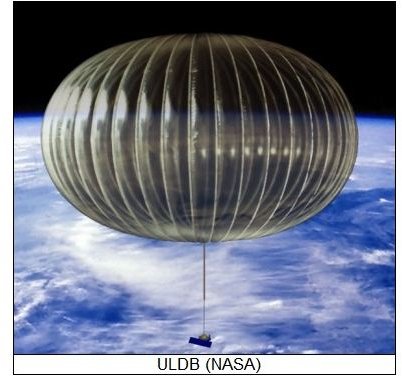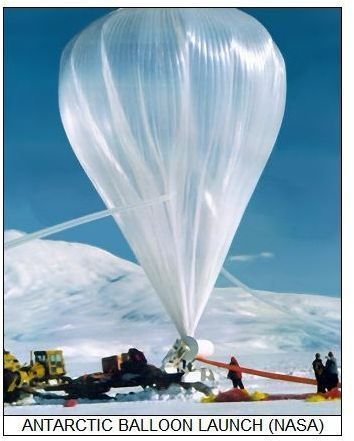Balloons: How They Are Used in Astronomy
Balloons In Astronomy: Basic Principle
Balloons have both recreational and scientific purposes.There are hot air balloons and gas balloons. The basic principle behind the launching of balloons is the ‘Archimedes Principle’. According to the Archimedes Principle “ when a body is immersed in a fluid, it experiences an upward thrust equal to the weight of the fluid displaced by it”. Therefore the larger the balloon, the more air it can displace, the larger the upward thrust it will experience and the more weight it can carry. Thus balloons act as a launch vehicle to get scientific instruments into the upper atmosphere. Usually, they are launched when the winds in the upper atmosphere are favorable. The balloons are tracked using radar technology, radio or GPS systems.
Balloons used in astronomical research carry instruments like spectrometers, bolometers, and telescopes and are used to study various phenomenon in the cosmos. The information collected by the balloons are then transferred to the ground stations directly or through a satellite communication link.
Types of Balloons
In the case of hot air balloons, the buoyant force is provided by the heating the air inside it. They are mainly used for recreational purposes.
Gas balloons are used for carrying out scientific research. They play an indispensable role in the field of astronomy. Usually, a specially made thin film is used to form an envelope for the balloon. The balloons are inflated with lighter than air gases like hydrogen and helium, which have a density lower than the surrounding atmosphere. Hydrogen is the lightest among all gases, but it is not preferred as it is highly flammable, hence scientific ballooning uses helium.
Three types of balloons are used in the field of science:
Rubber or Neoprene balloon: As the inflated balloon starts to ascend the expansion of gas inside cause the stretching of Neoprene. This process goes on till the balloon reaches about 30 to 200 times its initial volume. At this point the neoprene cover ruptures and its mission is over. The instrument in the balloon reaches the ground with the help of a small parachute connected to it.
Zero Pressure balloon: This balloon is used to carry out research at a predetermined altitude. The balloon is made of polyethylene and has a valve fitted to it. It is partially inflated while it is on the ground. As the balloon rises, the gas expands and when it reaches the expected altitude, automatic discharge of excess gas occurs through the valve. After sunset the gas inside the balloon cools and contracts reducing the balloon’s volume and this causes the balloon to descend. If this mission is to be carried out for more than one day then it is filled with a ballast, usually sand. When the balloon starts to descend after sunset a small portion of ballast is released and thus the balloon remains at altitude. During day time, the gas again expands but the balloon ascends to higher altitude as it is lighter than before. Again, it automatically releases the excess gas to settle at the preset altitude. This process goes on until it runs out of the ballast and after several days the mission is over. NASA has developed zero pressure balloons using special polyethylene film, which were launched in December 2008. The image on left is that of the Zero-pressure balloon in its test launching in Antarctic.
Super Pressure Balloon: Internal pressure of super pressure balloon is maintained higher than the atmospheric pressure so as to keep its density at an approximately constant value to control its altitude. It is preferred over the Zero-pressure balloons due to its ability to stay at altitude for extended periods of time.

The image on left is that of a Super Pressure Balloon.
Balloon Based Discoveries In Astronomy
- It has detected the presence of the cosmic background radiation, which is identical to that produced by a black body at 3ºK.
- The high energy infrared radiation emitted from the galactic center is recorded by telescopes in balloons.
- The constituents of primary cosmic rays were detected by the instruments carried by these balloons.
- Balloon borne spectrometers have recorded the spectrum of electrons in space. This helped scientists to measure the galactic magnetic field.
- In 1959, balloons were used to record the X-ray spectrum produced by solar flares and this led to the confirmation for ‘non-thermal solar acceleration of electrons’.
- The presence of the pulsar NP-0532 was first detected by the data gathered from one of the balloon expeditions.

The recent SUNRISE Mission was carried out with the help of giant helium balloons. The solar telescope on board of this zero pressure balloon provided high quality images of solar atmosphere. It provided information on magnetic structures in the solar atmosphere. The bubbling solar surface in which gas bubbles are formed and disappeared continuously under the influence of solar magnetic fields was photographed with excellent optical quality, which was unattainable from the surface of the Earth due to disturbances caused by the atmosphere. The picture above shows an image of the solar surface obtained from the SUNRISE mission.
Optical telescopes are incorporated with balloons to study objects in space from high altitudes, which are free from the dust and humidity of the lower atmosphere. The collection of dust particles from space, which are accumulated in the stratosphere is also carried out using balloons, as well as the recording of electric fields in the magnetosphere over wide spread regions.
Super pressure balloons have been proposed to study the atmosphere of Mars.
In addition to the vast amount of information collected using balloons, they have an important role in the launching of satellites. That is, the instruments, which are to be incorporated into a satellite, are launched using balloons to test out the equipment and make changes in its design so that it will produce accurate results when it is launched into space. This testing is impossible, or extremely expensive to do using a satellite.
Balloons are cheaper in comparison with satellites. The time required for the design and development of a balloon launching is negligible. The fast moving satellites are ineffective in studying the magnetosphere, as there are simultaneous temporal and spatial variations in the phenomenon occurring in the magnetosphere. Whereas, the accurate measurement of temporal variations are possible with balloons, which move at a slower pace. Finally, in the present scenario, recovery and reuse is possible only with balloons. Even though balloons have a number of benefits they can’t replace satellites, as the latter’s capacity to gather information is immense with its much higher elevation and longer time to make observations.
Sources
The use of balloons for physics and astronomy by National Research Council (U.S.). Balloon Study Committee
https://science.jrank.org/pages/731/Balloon.html
https://www.vectorsite.net/avbloon_5.html
https://www.centennialofflight.gov/essay/Dictionary/Scientific_Balloons/DI72.htm
https://www.techbriefs.com/component/content/article/1197
https://www.mps.mpg.de/en/projekte/sunrise/
Image:
https://www.vectorsite.net/avbloon_5.html
https://www.mps.mpg.de/en/aktuelles/pressenotizen/pressenotiz_20091104.html
